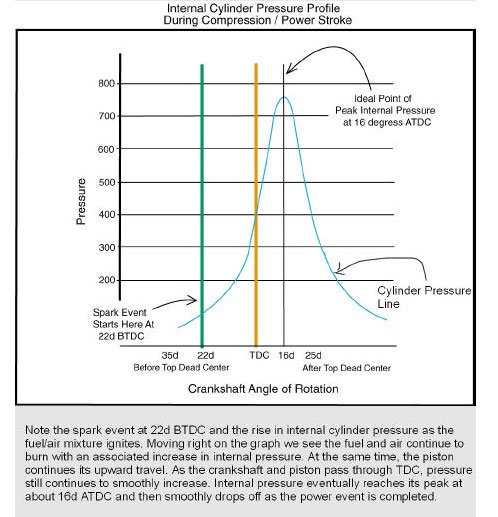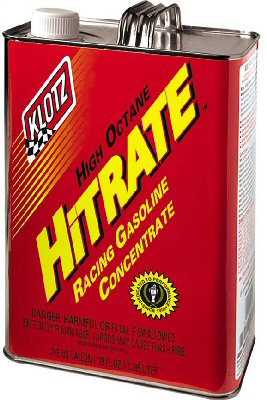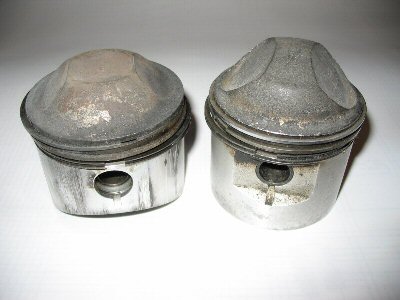Well, it seems a little confusing to some.
Then I clean 
Carburants et moteurs: technologies, énergie, environnement, Volume 1
Citation:
These are two frequently mentioned to deter us from stealing the poor side events.
The detonation was more frightening than a pre-ignition then
name than in reality detonation rarely gives damage and
pre-ignition cylinder destroyed in seconds.

Detonation (castanet, knock, knocking)
It always occurs after the spark due to an increase in pressure
and temperature.
The factors favoring detonation high compression ratio, high
temperature air-fuel mixture, a spark advance too large and low
octane.
It is accompanied by a peak pressure of very short duration in
the combustion chamber, which is responsible for a high-pitched
noise (knocking) that we had no chance to hear in our aircraft.
An engine detonates tends to heat, this overheating increasing
the detonation.
We observe an increase in CHT in the case of detonation.
against by the detonation is accompanied by a discrete lower EGT
(or no decline at all), which may be falsely reassuring.
The detonation is not necessarily destructive: the engines can
click very long without being damaged
The pre-ignition (pre-ignition, pinking)
This is the combustion of the air-fuel before the spark plug.
This pre-ignition is caused by a spark-plug-heated or carbon
deposits in the combustion chamber.
It occurs when the air-fuel mixture is the flame retardant, so
low pressure, so in the early stages of compression, immediately
before or after the PMB so about 180 ° BTDC ...
The result is easily understood: the piston then compresses a
mass of hot gas expanding resulting in a tremendous increase in
pressure and heat in the cylinder for a long time (180 ° of the
compression phase).
Because of this long-term there is no explosion or abnormal
noise in the engine.
But the damage is considerable quickly, usually a hole in the
middle of the piston in a few revolutions.
The pre-ignition resulting in an increase in CHT and a drastic
drop in EGT and internal destruction of a cylinder, piston,
connecting rod in flight: it is therefore a situation of extreme
urgency since the integrity of the engine is game
The conclusion
What destroys an engine that is pre-ignition, it occurs when hot
spot inside a cylinder, usually a spark-plug damaged.<
Detonation is most often benign.
It can cause pre-ignition if it is liable for damage to a
spark-plug tied to engine overheating.
|
Threshold of knocking |
May 2008
A miracle happened using Klotz Hitrate Octane Booster

I was able to drive at 120 Mph at over 7000 rpm like in the 70's when "red" super leaded fuel was available
But the next day, total disappointment, given that it had been more than an hour since I opened the gallon, the active effect of the product had
disappeared since it is extremely volatile and the engine detonation returned preventing me from going more than 105 Mph
To summarize, whether you leave the product in the gallon or in the tank, the product disappears after an hour
December 2012
After thirty years of experimentation with
modern gasoline lead on T120R 750 without, I came to these findings.
Based on the difference in octane number of
gasoline type.
More octane gasoline will be less high burn
quickly and will put more spark advance to avoid the problem of detonation (knocking)
The regular unleaded gasoline burns faster
than unleaded petrol.
I might add that the unleaded fuel burns
faster than super leaded gasoline.
There is also the problem of pre-ignition (pinking) which is inversely proportional to the octane.
Pre-ignition is proportional to the
increase in the compression ratio of a combustion chamber.
With unleaded gasoline modern, I believe it
is better to reduce the ignition advance of our old British
motorcycles at the time set for leaded gasoline that burned more
slowly than unleaded gasoline modern.
The method of reducing the compression ratio
of 8.5:1 low while keeping the 38° full-advance is as valid
I experienced the method of adding a thicker
head gasket to lower compression ratio and detonation much
less for the same spark advance.
Recently I gave the original gasket for my
9.5:1 Morgo kit and detonation climbed several notches even though I
already drove 32° full-advance according to the
curve of Pazon
I prefer the gasket under normal thickness to
avoid burning the yoke in the middle.
Currently I'm looking in the field of
detonation threshold for my current setup.
At 24° full-advance I do not perceive any detonation regime in all gears a Triumph Unit
I think the threshold is between 26-30°
In modern vehicles a new gadget was designed
to counteract the nuisance of detonation.
Knock-sensor is the name and this gadget is
connected to the electronic ignition of the vehicle to move ahead
automatically in case of detonation.
Many American cars (Dodge Caliber) and German
use a knock-sensor
Here a link that explains the principle of operation
http://www.bosch.com.au/content/language1/html/4563.htm
To be honest, 95% of the time I have suffered
the inconvenience of detonation on T120R except the summer
of 2011 while returning from Parent or motorcycle placed himself in pre-ignition
due to excessive accumulation of carbon to the
2-stroke oil that I added in too large a proportion in the fuel
tank.
Carbon overheated took precedence over the
ignition and prevented me from rolling more than 110 Km/h
In fact, the pre-ignition is almost
silent compared to detonation, but it greatly damped engine
power and damage the engine.
I avoided forcing the engine to return to
Quebec without getting towed.
It is certain that I will not force my chance
to resettle piston 11.0:1 compression ratio as before.
For I fear that the decline in the ignition
can not compensate for detonation with the addition of more
pre-ignition
Photo of Morgo 9.5:1 and 11.0:1 Max Power
Two piston type that requires special
preparation of the bike with the modern super unleaded gasoline


The diesel engines do not really use the pre-ignition
for their operation, but it comes close.
Rather, it is the term auto-ignition of to remember for them.
The mixture will turn on by itself when the
temperature of the compressed air reaches a specified degree of heat.
Sometimes a glow-plug is used to start its operation.
Any hot spot to the heating of carbon in one
spot just trigger the problem pre-ignition which translate
into low auto-ignition gasoline engines.
I experienced the phenomenon of
auto-ignition with a Suzuki GT750 two three cylindes 1972 times.
After a few minutes of warming up, the engine
placa auto-ignition turning at full speed of fashion.
I put the key to off, remove the spark plug
caps, nothing to do, it was still running at full speed.
On landing vitement carburetors and gearing
while modulating the engine with the clutch, I managed to stop it.
The reason for all hither, two-stroke oil low
end does not correspond with the Suzuki standards
December 2014
During the summer, I added 8 oz of Torco per tank of gas and the rest of the detonation partially disappeared when driving at 28° full-advance,
but not completely as I experienced in 2008 with the Klotz Hitrate
|